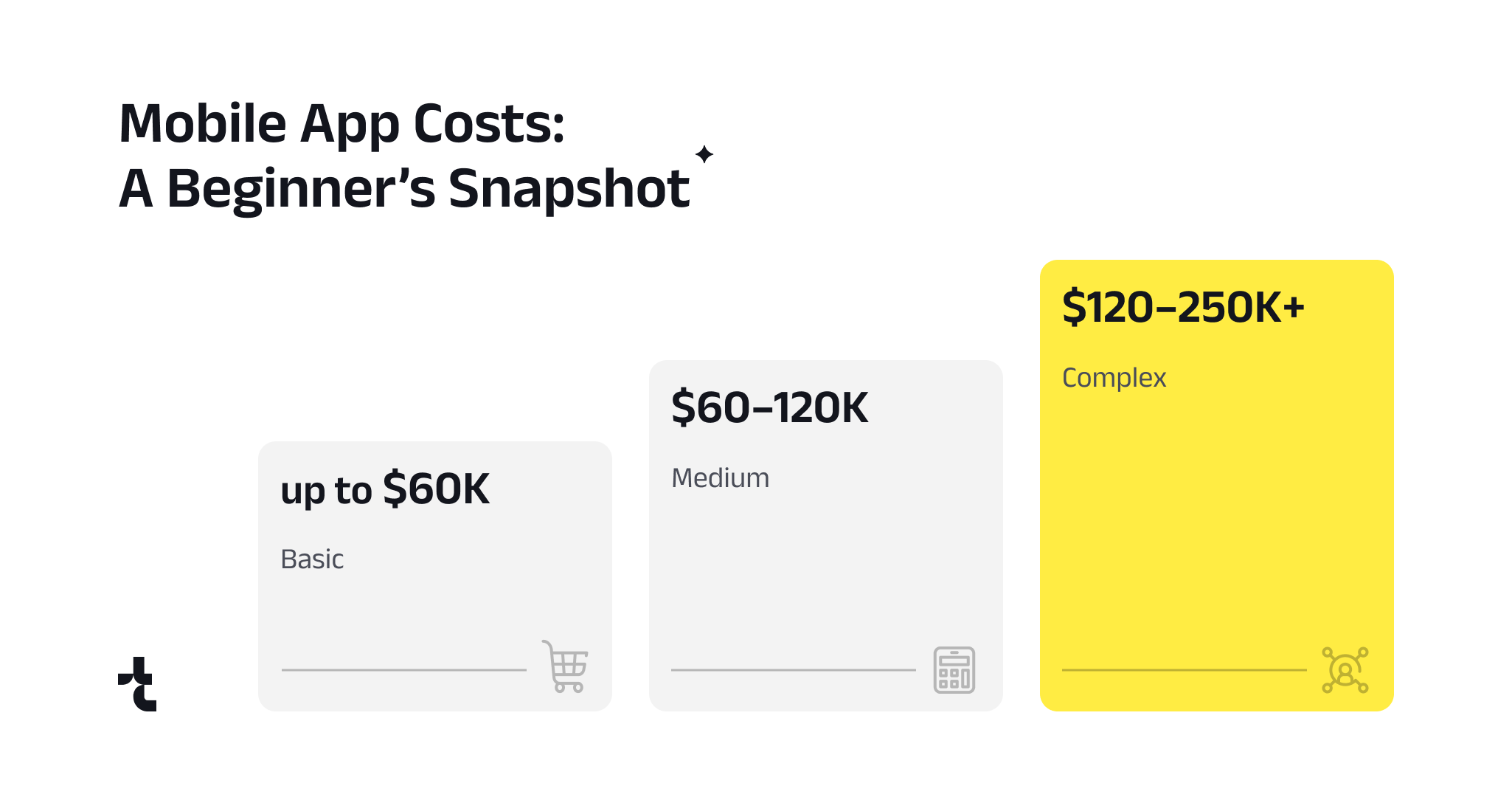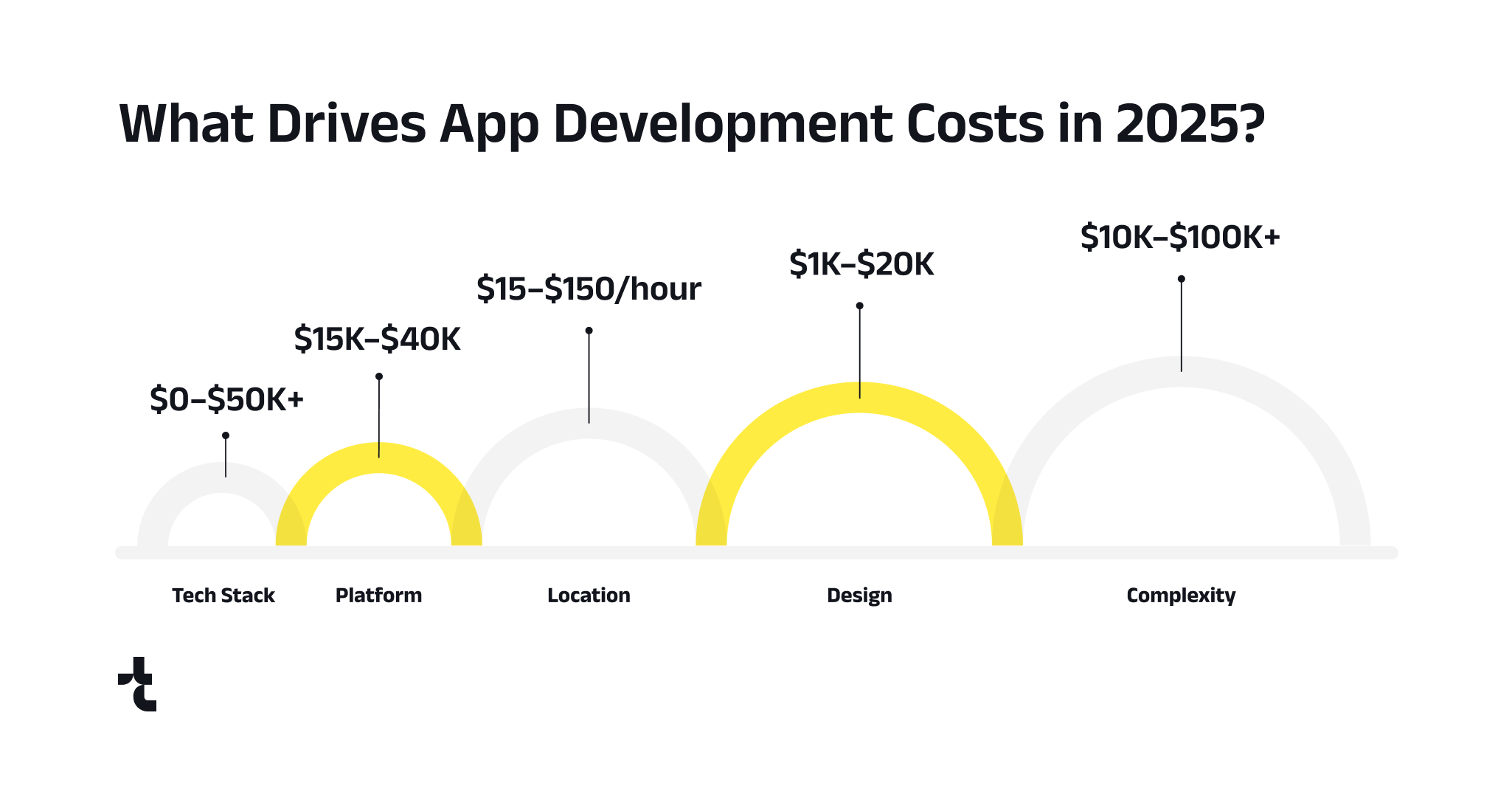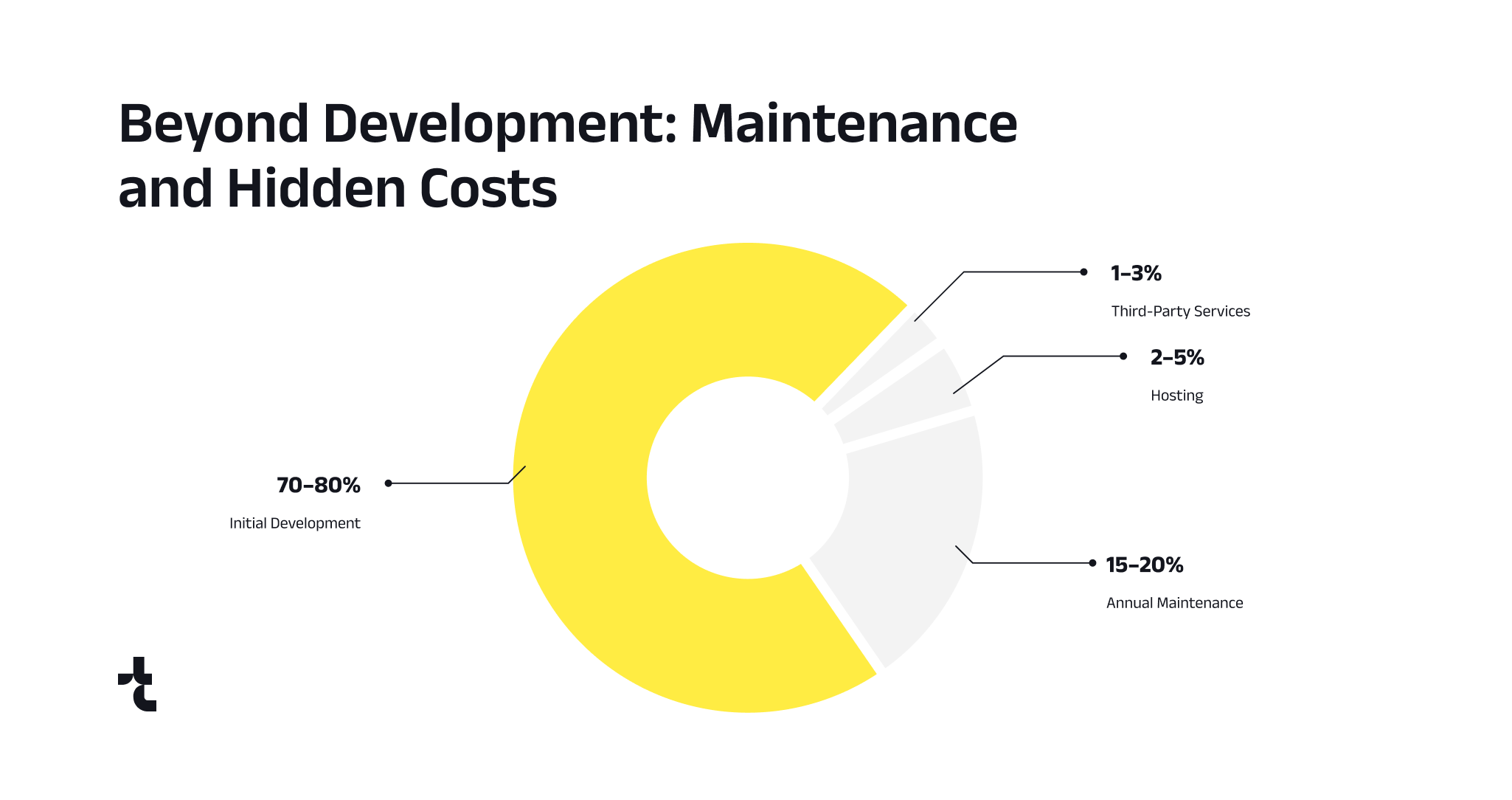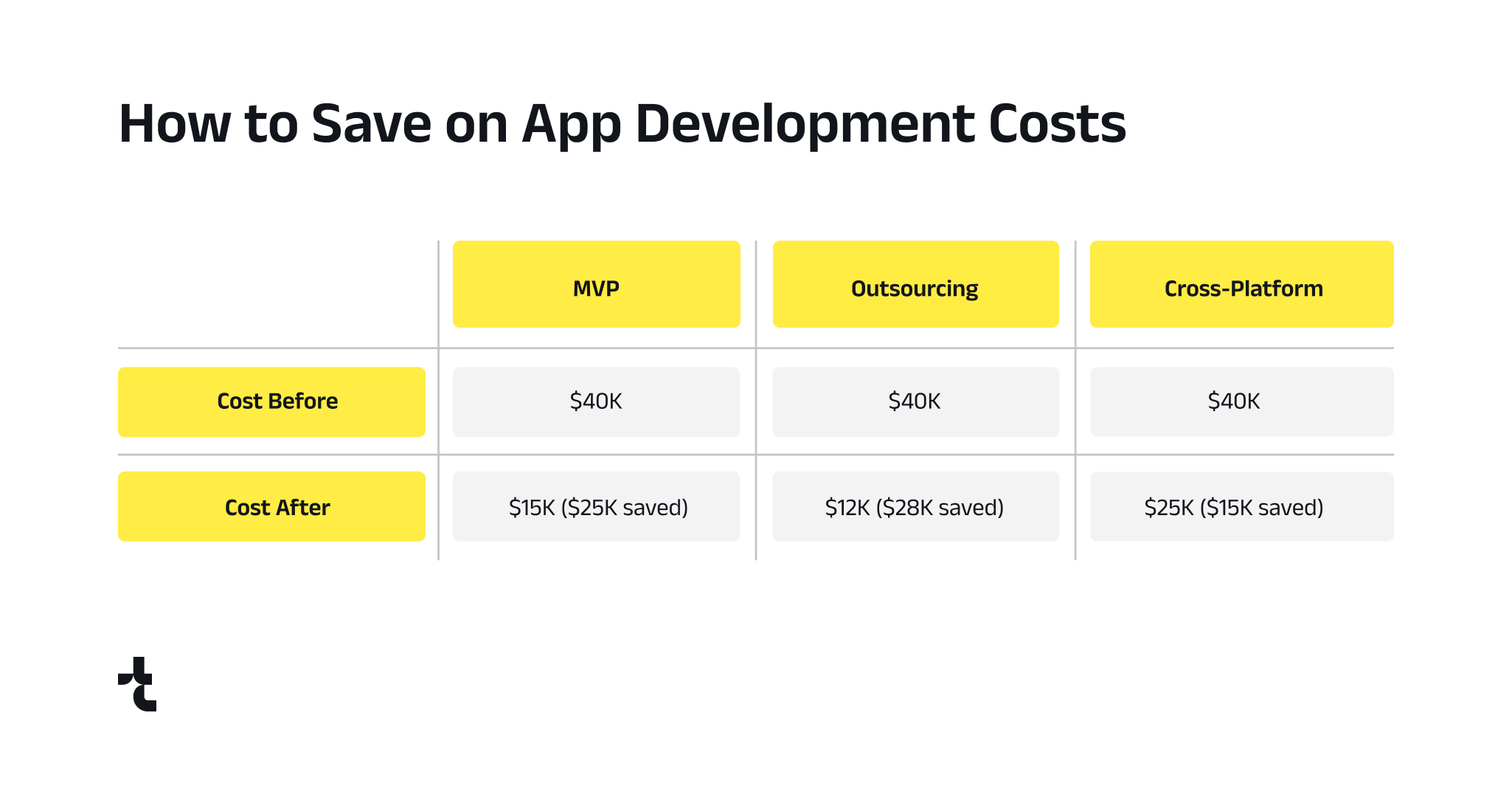How Much Does Mobile App Development Cost in 2025? Your Ultimate Guide
Alina Ramanenkava, Growth Marketing Manager
April 21, 2025
Thinking of building a mobile app in 2025? Whether you’re dreaming up a simple fitness tracker or a complex social platform, one question looms large: How much will it cost? The answer isn’t one-size-fits-all—app development costs can range from a modest $10,000 to a hefty $150,000 or more, depending on what you’re aiming for.
Don’t overpay or get caught off guard! Understanding the factors that drive these costs is the first step to budgeting smartly and bringing your idea to life.
In this guide, we’ve got you covered with everything you need to know about mobile app development costs in 2025. We’ll break down the key drivers—like complexity, design, and team location—offer cost estimates for different app types, and reveal how regional rates can make or break your budget. Plus, you’ll find real-world examples, practical tips to save money (think MVPs and outsourcing), and even a peek at those hidden costs that sneak up after launch.
Backed by insights from industry leaders and updated for today’s market, this is your roadmap to planning a project that fits your vision—and your wallet. Ready to dive in? Let’s get started.
Mobile app costs: a beginner’s snapshot
New to app development? Don’t worry—we’ll keep it simple. The cost to build a mobile app in 2025 depends on its complexity, but here’s a quick look at what you might expect: basic apps start at $10,000–$25,000, medium-complexity apps range from $25,000–$60,000, and complex apps can climb to $60,000–$150,000 or more. These numbers aren’t set in stone—they shift based on features, design, and where your team is based—but they’re a solid starting point to get your bearings.
- Basic Apps ($10,000–$60,000): Think calculators, to-do lists, or simple fitness trackers. These apps have minimal features—like a clean interface and basic functionality—and don’t need heavy backend work. Perfect for testing an idea without breaking the bank.
- Medium Complexity Apps ($60,000–$120,000): Picture e-commerce stores or booking apps. They pack more punch with user logins, payment systems, and some custom design, but they’re still manageable for small businesses or startups.
- Complex Apps ($120,000–$250,000+): These are the heavy hitters—think social media platforms, on-demand services, or apps with advanced tech like AI or blockchain. They demand robust systems, top-tier design, and often months of development.
Want a visual? Check out the infographic below for a quick breakdown. This is just the tip of the iceberg—keep reading to uncover what drives these costs and how to tailor them to your project.
What drives app development costs in 2025?
So, why do app costs vary so wildly—from $10,000 to over $250,000? It’s not magic; it’s a mix of factors that shape your project’s price tag. Understanding these drivers is key to budgeting smarter and avoiding surprises. Let’s break it down into five core elements that every app owner should know: complexity, design, team location, platform choice, and tech stack. Here’s how they work—and what they mean for your wallet.
App complexity and features
The more your app does, the more it costs—it’s that simple. A basic app with a few screens (say, a to-do list) might take 200 hours to build, landing at $10,000–$20,000. Add features like user profiles, push notifications, or real-time chat, and you’re looking at 400–800 hours, pushing costs to $25,000–$60,000. Go big with AI, live streaming, or custom algorithms—like a social media app—and you could hit 1,000+ hours and $100,000+. More features mean more coding, testing, and time.
Design and user experience
Looks matter. A simple, off-the-shelf design might cost $1,000–$5,000—think templates with basic tweaks. Want a custom UI/UX that wows users, like a sleek e-commerce app? That’s $5,000–$15,000, factoring in wireframes, animations, and user testing. High-end designs for complex apps (e.g., a polished on-demand service) can top $20,000. Skimp here, and you risk losing users; invest wisely, and you boost engagement.
Development team location
Where your developers are based can slash or spike your budget. We’ll dive deeper in Section 4, but here’s the gist: hiring in North America runs $50–$150/hour, while Eastern Europe offers $20–$50/hour for similar quality. A $30,000 app in Asia might cost $75,000 in the USA. Location isn’t just about rates—it’s about communication and expertise, too.
Platform choice
iOS, Android, or both? Building for one platform (e.g., iOS with Swift) is cheaper—say, $15,000 for a basic app. Dual-platform development doubles the effort, hitting $25,000–$40,000. Cross-platform tools like Flutter or React Native can cut costs (e.g., $20,000 for both), but they might limit performance for complex apps. Your audience decides this one.
Integration and tech stack
Need your app to sync with APIs, databases, or cutting-edge tech? Integrations add up. A simple app with minimal backend (e.g., local storage) stays lean. Add payment gateways or cloud syncing, and you’re at $15,000–$30,000 extra. Go advanced—like blockchain for a crypto app (think Asian Bank’s $200,000+ project)—and costs soar with specialized skills and security needs.
Check out the chart below to see how these factors stack up. Each choice you make tweaks the final price—master them, and you’ll keep costs in check.
How much does your app type cost?
Not all apps are built the same—your project’s scope shapes its price tag. Whether you’re envisioning a straightforward tool or a feature-rich platform, understanding typical costs for your app type helps you plan with clarity. Below, we break down three categories—simple, medium complexity, and complex—with updated cost ranges, features, and real-world examples from Timspark’s 2025 portfolio. Here’s the breakdown.
Simple apps (up to $60,000)
These are lean and focused: apps with core functionality and minimal extras. Think basic trackers, calculators, or streamlined tools. You’re investing in a clean interface, a few screens, and perhaps local storage—no heavy infrastructure needed. Development typically takes 200–400 hours. Costs? Up to $60,000, depending on team rates.
Timspark example: Our AI-Driven Health Management App launched for a minimum of $50,000. It delivered essential health tracking with a sleek UX, proving you can make an impact without breaking the bank.
Medium complexity apps ($60,000–$120,000)
Here’s where things get more dynamic—apps like e-commerce platforms, booking systems, or specialized trackers. Expect user accounts, payment integrations, push notifications, and tailored designs to shine. These projects clock 400–800 hours, with costs ranging from $60,000 to $120,000.
Timspark example: Our Computer Vision in Agriculture App for bee population tracking, built for a minimum of $80,000, blended advanced tech with intuitive UX to support environmental monitoring—a perfect fit for growing ventures.
Complex apps ($120,000–$250,000+)
These are the heavyweights: apps with sophisticated features like social networks, on-demand services, or cutting-edge tech such as AI, blockchain, or telehealth. They require robust backends, high-grade security, and often 1,000+ hours of development. Costs start at $120,000 and can climb well beyond $250,000 for ambitious visions.
Timspark examples:
- Our Mobile App for Data Security with Blockchain, starting at $100,000, delivered secure data handling with complex integrations.
- Our KYC Framework for iOS and Android, kicking off at $120,000, streamlined compliance with seamless cross-platform performance.
- For top-tier projects, our Digital Wallet Mobile App and Telehealth Solution for iOS and Android, both starting at $250,000, showcase scalable, secure, and innovative platforms built for global reach.
The table below summarizes features, hours, and costs to help you pinpoint where your app lands. Your project might blend these categories, but this framework offers a clear starting point.
Category | Cost Range | Development Hours | Typical Features | Timspark Example |
Simple Apps | Up to $60,000 | 200–400 | Clean UI, basic functionality, local storage | |
Medium Complexity Apps | $60,000–$120,000 | 400–800 | User accounts, payments, push notifications, custom design | Bee Population Tracking App ($80K min) |
Complex Apps | $120,000–$250,000+ | 1,000+ | Robust backends, high security, AI/blockchain, scalable systems | Blockchain Data Security App ($100K min), KYC Framework ($120K min), Digital Wallet & Telehealth Solution ($250K min each) |
How location affects app development costs
Hiring in the USA or Canada means top-tier talent—think Silicon Valley pros or Toronto’s tech hubs. Rates run $50–$150/hour, reflecting high demand and living costs. You get cutting-edge skills and smooth collaboration if you’re local, but a simple 400-hour app could hit $20,000–$60,000. Perfect for complex projects needing innovation, less so for tight budgets.
Western Europe ($40–$100/hour)
The UK, Germany, or Scandinavia offer a strong mix of quality and reliability at $40–$100/hour. You’re still close to North American time zones, with robust tech scenes—think London startups or Berlin’s dev community. That same 400-hour app? $16,000–$40,000. It’s a sweet spot if you want premium work without the top-end price.
Eastern Europe ($20–$50/hour)
Asia ($15–$40/hour)
India, Vietnam, or the Philippines bring the lowest rates—$15–$40/hour—making that 400-hour app just $6,000–$16,000. You’ll find solid talent pools here, but watch for time zone lags or cultural gaps that might slow communication. Ideal for budget-conscious projects with clear specs.
See the bar chart below for a quick visual on how rates compare. Pair this with your app’s complexity, and you’ll spot the smartest hire for your goals—whether it’s local expertise or global savings.
Region | Hourly Rate Range | Notes |
North America | $50–$150 | High-end talent, premium costs |
Western Europe | $40–$100 | Quality with moderate pricing |
Eastern Europe | $20–$50 | Cost-effective, skilled workforce |
Asia | $15–$40 | Lowest rates, potential time zone gaps |
Beyond development: maintenance and hidden costs
Think the bill’s settled once your app launches? Not quite.
Development is just the start—keeping your app running smoothly in 2025 comes with its own costs, often overlooked until they hit. From updates to server fees, these expenses can add up fast, so let’s peel back the curtain on what’s lurking post-launch and how to plan for it.
Maintenance is the big one—expect to spend 15–20% of your initial development cost annually to keep things humming. Built a $50,000 app? That’s $7,500–$10,000 a year for bug fixes, performance tweaks, and compatibility updates (think new iOS or Android versions). Skip this, and your app risks crashing or losing users.
Then there’s hosting: a basic app might need $100–$500/year for servers, but a complex one with heavy traffic—like a social platform—could hit $1,000–$5,000 or more. Add in third-party services—payment gateways ($100–$500/year), analytics tools ($50–$200/year)—and you’ve got a steady drip of costs.
Real-world example: A medium-complexity e-commerce app launched for $40,000 might face $8,000 in annual upkeep—$6,000 for maintenance, $1,000 for hosting, $1,000 for extras. Compare that to a simple calorie counter at $15,000, where $3,000/year covers it. The pie chart below breaks it down, showing how initial vs. ongoing costs stack up. Factor these in early, and you’ll avoid budget shock down the road.
How to save on app development costs
Building an app doesn’t have to drain your bank account—smart choices can slash costs without sacrificing quality. In 2025, with budgets tighter and competition fiercer, optimizing your spend is a game-changer. Here are three proven strategies to keep your project lean: starting with an MVP, outsourcing to cost-effective regions, and leveraging cross-platform tools. Let’s see how they work—and what you could save.
Build a Minimum Viable Product (MVP)
Why build everything at once? An MVP focuses on core features to test your idea fast and cheap. A full e-commerce app might cost $40,000, but an MVP with just browsing and checkout could launch for $15,000—saving 60% upfront. Appinventiv’s JobGet project nailed this: a $20,000 MVP got them to market, gathering user feedback before a bigger build. Spend less now, scale later—it’s the startup playbook.
Outsource to cost-effective regions
Location matters—big time. Hire in North America at $100/hour, and a 400-hour app costs $40,000. Shift to Eastern Europe at $30/hour, and it’s $12,000—a 70% drop. Asia’s even cheaper at $20/hour, landing you at $8,000. Quality holds up in places like Poland or India if you pick vetted teams. The trick? Clear specs and good communication to avoid hiccups.
Use cross-platform tools
Case Studies: App development costs in action
Numbers give you a framework, but real-world examples make it click. These 2025 case studies from Timspark’s portfolio—covering simple, medium, and complex apps—show how costs come together in actual projects. From lean startups to enterprise-grade builds, here’s what businesses invested, why, and what their experiences teach us.
Simple App: AI-Driven Health Management App ($50,000)
A health-tech startup wanted a straightforward app to track user wellness data—functional, focused, and market-ready. Built by Timspark’s team at a competitive rate, this 400-hour project hit a minimum of $50,000. It included a clean UI, local storage, and a single-platform rollout (iOS), with basic AI to personalize insights—no complex backend required.
Why the cost? A polished yet minimal feature set kept it lean.
Takeaway: For under $60,000, a simple app with smart tech can launch effectively if you prioritize essentials and choose an efficient team.
Medium complexity app: Computer Vision in agriculture ($80,000)
An environmental firm needed an app to track bee populations using computer vision—a step up in complexity. This cross-platform solution, built with optimized frameworks to avoid dual-development costs, started at $80,000 for roughly 600 hours. Features included real-time data processing, user accounts, and a custom UX to visualize insights. Timspark’s team added $10,000 for specialized CV integration, with year-one maintenance at $15,000.
Why the cost? Advanced tech and cross-platform needs pushed the budget, but streamlined tools kept it in check.
Takeaway: Picking cost-effective frameworks and a skilled team balances innovation and affordability.
Complex app: Digital wallet mobile app ($250,000)
A fintech client aimed for a secure, scalable digital wallet with global reach—think seamless payments, robust encryption, and cross-platform performance. This beast of a project, clocking over 1,200 hours, started at $250,000. Costs reflected a high-caliber backend, top-tier security, and compliance features, with Timspark’s team optimizing via an MVP to avoid ballooning expenses. Annual maintenance runs $50,000—20% of the initial spend.
Why the cost? Sophisticated infrastructure and regulatory demands drove the price.
Key insight: Ambitious apps need big budgets, but a phased approach can manage the hit while delivering impact.
These cases weave together complexity, team efficiency, and optimization strategies into tangible budgets. Your app might blend these elements—use these stories as a guide to chart your own course.
Plan your app development budget in 2025
Ready to turn your idea into reality? App costs in 2025 hinge on a few big truths: complexity sets the baseline, location tweaks the price, and ongoing costs keep it running.
A simple app might start at $20,000, while a complex one tops $250,000—but smart moves like MVPs or outsourcing can save you thousands.
Take stock of your goals—features, timeline, audience—and match them to these insights.
Need a custom plan? Contact us for a quote tailored to your vision. Your app’s future starts now—make it count.





